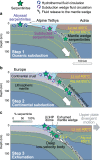Evidence for a serpentinized plate interface favouring continental subduction
- PMID: 32358508
- PMCID: PMC7195360
- DOI: 10.1038/s41467-020-15904-7
Evidence for a serpentinized plate interface favouring continental subduction
Erratum in
-
Author Correction: Evidence for a serpentinized plate interface favouring continental subduction.Nat Commun. 2020 Jul 28;11(1):3838. doi: 10.1038/s41467-020-17767-4. Nat Commun. 2020. PMID: 32724062 Free PMC article.
Abstract
The dynamics of continental subduction is largely controlled by the rheological properties of rocks involved along the subduction channel. Serpentinites have low viscosity at geological strain rates. However, compelling geophysical evidence of a serpentinite channel during continental subduction is still lacking. Here we show that anomalously low shear-wave seismic velocities are found beneath the Western Alps, along the plate interface between the European slab and the overlying Adriatic mantle. We propose that these seismic velocities indicate the stacked remnants of a weak fossilised serpentinite channel, which includes both slivers of abyssal serpentinite formed at the ocean floor and mantle-wedge serpentinite formed by fluid release from the subducting slab. Our results suggest that this serpentinized plate interface may have favoured the subduction of continental crust into the upper mantle and the formation/exhumation of ultra-high pressure metamorphic rocks, providing new constraints to develop the conceptual and quantitative understanding of continental-subduction dynamics.
Conflict of interest statement
The authors declare no competing interests.
Figures




References
-
- Abers GA. Seismic low-velocity layer at the top of subducting slabs: observations, predictions, and systematics. Phys. Earth Planet. 2005;149:7–29. doi: 10.1016/j.pepi.2004.10.002. - DOI
-
- Hilairet, N. et al. High-pressure creep of serpentine, interseismic deformation, and initiation of subduction. Science318 (2007). - PubMed
-
- Guillot S, Schwartz S, Reynard B, Agard P, Prigent C. Tectonic significance of serpentinites. Tectonophysics. 2015;646:1–19. doi: 10.1016/j.tecto.2015.01.020. - DOI
Grants and funding
LinkOut - more resources
Full Text Sources

